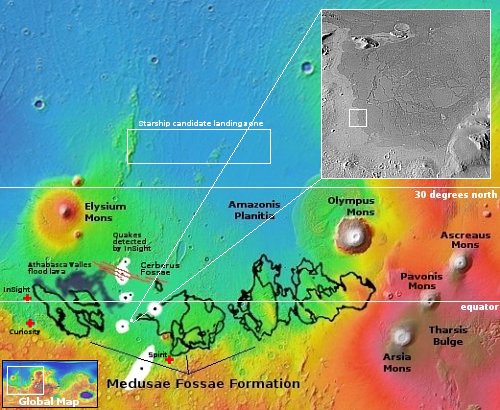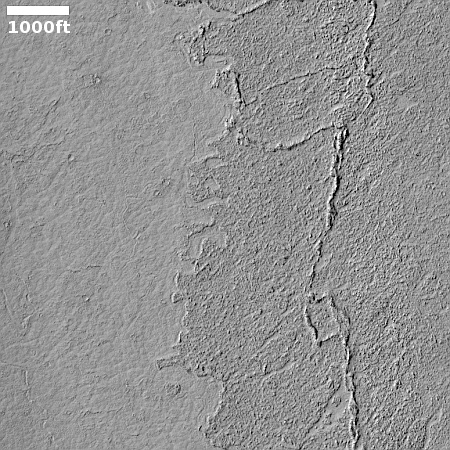The shoreline of a Martian lava sea
Cool image time! The picture to the right, cropped, reduced, and enhanced to post here, was taken on October 2, 2023 by the high resolution camera on Mars Reconnaissance Orbiter (MRO).
The science team labeled this a “lava margin.” The darker material on the right is apparently a newer deposit of lava, flowing on top of the lighter lava on the left. The newer deposit is only about three feet thick, so it had to have flowed fast almost like water to cover this large area with such a thin layer before freezing. Even so, this new lava layer has a roughness greater than the older layer below it. Either the older layer is smoother because of erosion from wind over eons, or the lava in these two layers was comprised of slightly different materials that froze with different textures.
The small ridges appear to be wrinkle ridges, created when material shrinks as it freezes.
This margin marks the edge of a very large flood lava event, as illustrated by the overview map below.

The white dot on the overview map to the right marks the location, within the region where the seismometer on the lander InSight detected the largest quakes on Mars. This region is also in an area of little volcanic dust, lying outside the Medusae Fossae Formation, the largest volcanic ash deposit on Mars.
The white box in the inset indicates the area covered by the photo above. This inset was produced from a global mosaic created from MRO’s wide-view context camera, and in wider views this sea of lava extends several hundred miles to the north and west, and could very well be the most extreme flow from the Athabasca flood lava event, beleved to be the most recent major volcanic eruption on Mars.
The ground rises to the south and west of this margin, suggesting that in many ways this is a shoreline, with the sea of lava filling the lower elevation before freezing. Both it and the lava layer below illustrate the extensive volcanic history of Mars, that several billion years ago dominated the geology of the red planet. In later eons water ice and wind might have played a part in shaping this landscape, but in the beginning the volcanism that produced Mars’ giant volcanoes and its extensive flood lava plains were what shaped this landscape, as we see it now.
On Christmas Eve 1968 three Americans became the first humans to visit another world. What they did to celebrate was unexpected and profound, and will be remembered throughout all human history. Genesis: the Story of Apollo 8, Robert Zimmerman's classic history of humanity's first journey to another world, tells that story, and it is now available as both an ebook and an audiobook, both with a foreword by Valerie Anders and a new introduction by Robert Zimmerman.
The print edition can be purchased at Amazon or from any other book seller. If you want an autographed copy the price is $60 for the hardback and $45 for the paperback, plus $8 shipping for each. Go here for purchasing details. The ebook is available everywhere for $5.99 (before discount) at amazon, or direct from my ebook publisher, ebookit. If you buy it from ebookit you don't support the big tech companies and the author gets a bigger cut much sooner.
The audiobook is also available at all these vendors, and is also free with a 30-day trial membership to Audible.
"Not simply about one mission, [Genesis] is also the history of America's quest for the moon... Zimmerman has done a masterful job of tying disparate events together into a solid account of one of America's greatest human triumphs."--San Antonio Express-News
Cool image time! The picture to the right, cropped, reduced, and enhanced to post here, was taken on October 2, 2023 by the high resolution camera on Mars Reconnaissance Orbiter (MRO).
The science team labeled this a “lava margin.” The darker material on the right is apparently a newer deposit of lava, flowing on top of the lighter lava on the left. The newer deposit is only about three feet thick, so it had to have flowed fast almost like water to cover this large area with such a thin layer before freezing. Even so, this new lava layer has a roughness greater than the older layer below it. Either the older layer is smoother because of erosion from wind over eons, or the lava in these two layers was comprised of slightly different materials that froze with different textures.
The small ridges appear to be wrinkle ridges, created when material shrinks as it freezes.
This margin marks the edge of a very large flood lava event, as illustrated by the overview map below.

The white dot on the overview map to the right marks the location, within the region where the seismometer on the lander InSight detected the largest quakes on Mars. This region is also in an area of little volcanic dust, lying outside the Medusae Fossae Formation, the largest volcanic ash deposit on Mars.
The white box in the inset indicates the area covered by the photo above. This inset was produced from a global mosaic created from MRO’s wide-view context camera, and in wider views this sea of lava extends several hundred miles to the north and west, and could very well be the most extreme flow from the Athabasca flood lava event, beleved to be the most recent major volcanic eruption on Mars.
The ground rises to the south and west of this margin, suggesting that in many ways this is a shoreline, with the sea of lava filling the lower elevation before freezing. Both it and the lava layer below illustrate the extensive volcanic history of Mars, that several billion years ago dominated the geology of the red planet. In later eons water ice and wind might have played a part in shaping this landscape, but in the beginning the volcanism that produced Mars’ giant volcanoes and its extensive flood lava plains were what shaped this landscape, as we see it now.
On Christmas Eve 1968 three Americans became the first humans to visit another world. What they did to celebrate was unexpected and profound, and will be remembered throughout all human history. Genesis: the Story of Apollo 8, Robert Zimmerman's classic history of humanity's first journey to another world, tells that story, and it is now available as both an ebook and an audiobook, both with a foreword by Valerie Anders and a new introduction by Robert Zimmerman.
The print edition can be purchased at Amazon or from any other book seller. If you want an autographed copy the price is $60 for the hardback and $45 for the paperback, plus $8 shipping for each. Go here for purchasing details. The ebook is available everywhere for $5.99 (before discount) at amazon, or direct from my ebook publisher, ebookit. If you buy it from ebookit you don't support the big tech companies and the author gets a bigger cut much sooner.
The audiobook is also available at all these vendors, and is also free with a 30-day trial membership to Audible.
"Not simply about one mission, [Genesis] is also the history of America's quest for the moon... Zimmerman has done a masterful job of tying disparate events together into a solid account of one of America's greatest human triumphs."--San Antonio Express-News


